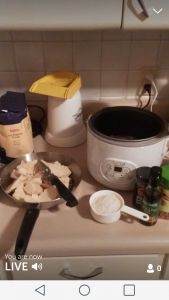Libraries connect people with information and technology is constantly providing us with new ways to reach our communities. Streaming—the broadcast of live video, generally from the camera on a smartphone or mobile device—promises to be a great way to share programming and wow our users with new resources. Streaming probably won’t be the centerpiece of your communication strategy, but it does have appeal as a sporadic tool for special events. The number of choices available for platforms, the ease of use, and the excitement of live broadcasts all mean that it might be a great fit for your library.
Facebook is everywhere—even the most small-scale libraries ordinarily have some sort of Facebook presence. This might make it the ideal entry point for libraries looking to dive into streaming. Facebook is currently providing its streaming feature, Live Video, to a small number of iPhone users in the U.S. It’s integrated into Facebook’s existing architecture—to start streaming, you’ll tap Update Status, then select the Live Video icon. As with other status options, you can restrict which audience will see your stream. During the broadcast, you’ll be shown a real-time feed of comments from your viewers. Once you’ve finished, your stream will be saved on your timeline like any other video and available for your visitors to replay.
Facebook streaming will eventually be rolled out to more users, but, in the meantime, you might consider other alternatives to get some streaming practice. The current Big Two of streaming are Periscope and Meerkat. Periscope is owned by Twitter and available for iOS and Android devices. Its audience is pretty impressive: every day, its users are viewing not just hours, but nearly 40 years of video (just over 350,000 hours of video streamed per day). It remains to be seen how Facebook streaming will affect those numbers, but for now Periscope offers an established platform that attracts a lot of eyes. Broadcasters have plenty of options for their streams—video can be available to the public or accessible only to a selected audience. Individual viewers can be blocked, so you won’t have to worry about rowdies wrecking your broadcast. Broadcasts (or “scopes”) disappear after 24 hours, although users can capture their scopes using resources like Katch. The Salt Lake City Public Library and Minnesota’s Hennepin County Library are among the profession’s Periscope enthusiasts. To see what’s possible with the platform, you might browse some of the archived videos on Katch—this brief scope gives viewers a taste of a library’s makerfaire, for instance. There’s also a new Facebook group devoted to Periscope in libraries that can provide some possible ideas.
Meerkat offers apps for iOS and Android. Once users have signed up, they can connect their Meerkat accounts to Facebook. This allows direct streaming to their followers as soon as they begin broadcasting and also permits the use of Meerkat’s Cameo feature. Cameo permits broadcasters to share control of their stream, giving invitees one minute of screen time and alerting his or her Facebook friends about the stream. Another Meerkat-specific feature is the end-of-broadcast button, which can direct your viewers to a particular site after the stream has ended. As with Periscope, Meerkat users can archive their streams with services like Katch. This BBC article on the Ferguson protests has tons of information about the benefits and challenges of the platform (although you should be aware that Meerkat no longer has direct connection with Twitter feeds).
There are, of course, other options for streaming beyond the Big Two. Ustream and Livestream were early entrants into the world of streaming and both are still strong contenders. For those who might be more comfortable with familiar names, YouTube also offers live streaming. Undoubtedly, new services will emerge as streaming becomes more and more popular. The right platform for your library depends, of course, on your needs. Features, cost, learning curve, and archiving options are all important considerations.
Streaming lets you show the world what’s happening at your library. It puts eyes on your programming, even outside the building, or allows you to give your users a sneak preview of new resources or remodeled areas. But it can also help to bring experiences from the wider world into your library. Why not follow up a travel program with a live broadcast from the place that was discussed or plan an author talk via Meerkat or Periscope? Streaming gives us powerful tools to widen our reach and create new connections between the library and its users.


